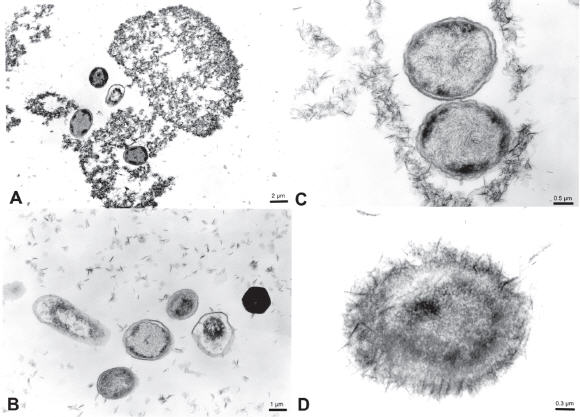Servicios Personalizados
Revista
Articulo
Indicadores
-
 Citado por SciELO
Citado por SciELO
Links relacionados
-
 Similares en
SciELO
Similares en
SciELO  uBio
uBio
Compartir
Revista argentina de microbiología
versión impresa ISSN 0325-7541versión On-line ISSN 1851-7617
Rev. argent. microbiol. v.41 n.4 Ciudad Autónoma de Buenos Aires oct./dic. 2009
IMÁGENES MICROBIOLÓGICAS
Bacterial hydrocarbon-degrading consortium from Antarctic soils
Removal of contaminants from polluted environments could be improved by taking advantage of the catabolic capacity of some microorganisms in a process called bioremediation. Nowadays, the use of microbial associations (also called microbial consortia) is gaining attention, because they seem to have a wider degradation spectrum than that exhibited by isolated strains. M10 is a bacterial consortium obtained from hydrocarbon-contaminated Antarctic soils. The members of the M10 consortium have been isolated and identified, being its main components bacteria belonging to the Pseudomonas, Sthenotrophomonas and Sphingobacterium genera (1). The use of the M10 consortium as a bioaugmentation tool proved to enhance phenanthrene removal from Antarctic soils (2). Transmission electronic microscopy (TEM) images of M10 revealed the presence of morphological diversity among the cells grown in liquid culture with phenanthrene as sole carbon and energy source (Figure1, A and B). This morphological diversity is in agreement with the idea of M10 as a complex microbial association. Images in Figure 1, C and D are compatible with the presence of an extracellular matrix around the cells. This matrix, that seems to be forcing or helping bacterial cells to stay close together is associated to the surface of only some members of the consortium.

Figure 1. Transmission electronic micrography of cells from the M10 bacterial consortium. The consortium was cultured using phenanthrene as sole carbon and energy source. A: 10.000X; B: 18.500X; C: 46.000X; D: 70.000X.
L.A.M. Ruberto1, S.C. Vázquez1, W.P. Mac Cormack2
1CONICET - Cátedra de Microbiología Industrial y Biotecnología, Facultad de Farmacia y Bioquímica, UBA, Junín 956 - 6º P (1113) CABA;
2Instituto Antártico Argentino, Cerrito 1248 (1010) CABA, Argentina.
E-mail: lruberto@ffyb.uba.ar
1. Mestre MC, Vázquez SC, Ruberto L, Mac Cormack WP. Identificación de los componentes cultivables del consorcio bacteriano degradador de hidrocarburos M10. Actas del VIº Simposio Argentino sobre Investigaciones Antárticas Disponible en: www.dna.gov.ar/CIENCIA/SANTAR07/CD/PDF/CVRE407.PDF Cód. CVRE407 2007; p. 5. [ Links ]
2. Ruberto LAM, Vázquez SC, Curtosi A, Mestre MC, Pelletier E, Mac Cormack WP. Phenanthrene bioremediation in soils using an Antarctic bacterial consortium. Bioremediation J 2006; 10: 191-201. [ Links ]














